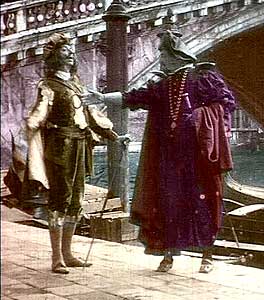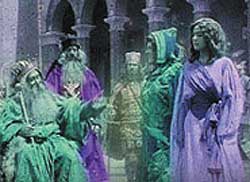 Shockingly beautiful sets & hand-colored in the most splendid manner, Gerolamo Lo Savio's ten minute silent adaptation of King Lear (Re Leer, 1910) is one of the two most lush & thrilling films in the dvd collecton Silent Shakespeare (2000).
Shockingly beautiful sets & hand-colored in the most splendid manner, Gerolamo Lo Savio's ten minute silent adaptation of King Lear (Re Leer, 1910) is one of the two most lush & thrilling films in the dvd collecton Silent Shakespeare (2000).
King Lear gives his third daughter, the shyly dignified Cordelia, an unjust portion of his kingdom because she was not as gushing & fawning as Regan & Gonoril, & he was a poor judge of sincerity.
ordelia as played by Francesca Bertini has a sorrowful beauty, very moving even as she performs in the silent film mode of extreme posturing.
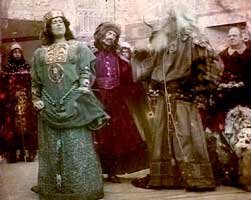 Now that she has her inheritance, Goneril the eldest daughter tires of the king's presence in her house. Now that she has her inheritance, Goneril the eldest daughter tires of the king's presence in her house.
When Lear demands fawning behavior from her as from his servants & his hunting dog, she just packs him off to Regan his second daughter to be rid of the pushy self-important king who gave away his country.
When he arrives at the estates of Regan, she meets his servants disdainfully, & himself worse yet.
Lear flees into the woods where he wails to heaven with grief & madness, with a pile of masonry as his only throne. A rock he finds upon the path he considers as the hearts of his daughter.
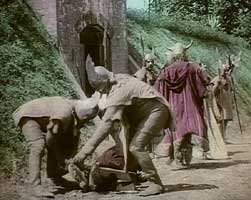 Cordelia informed by the Earl of Kent of her father's ordeal, living in a wattled hut fully out of his mind. Cordelia informed by the Earl of Kent of her father's ordeal, living in a wattled hut fully out of his mind.
She sends for him at once, eager to provide him a home. When he refuses to respond to her messengers, she comes for him personally, treating him with sensitivity in his childlike state until at last he regains his senses.
They might've lived happily ever after but that the elder daughters seek the assassination of the youngest, & King Lear dies seemingly from the sheer exhaustion & grief over the daughter he most wronged.
The condensation of a psychologically complicated play into a simple ten minute sketch may not do justice to Shakespeare, but as a silent film per se, this is so far ahead of the average.
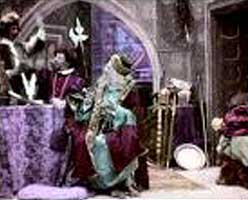 The same Italian director, Gerolamo Lo Savio, filmed another ten-minute condensation of Shakespeare, again gorgeously hand tinted in bright pastels that look like stained glass. The same Italian director, Gerolamo Lo Savio, filmed another ten-minute condensation of Shakespeare, again gorgeously hand tinted in bright pastels that look like stained glass.
Stunning costumes & location shots around Venice make Merchant of Venice Il Mercante di Venezia, 1910) a stunningly beautiful historical drama.
Antonio loves Jessica though she is the daughter of a Jew. Antonio's friend Bassanio asks for a loan of his friend so he can marry Portia, but Antonio's money is presently invested & he'll be living frugally until his ship of merchant's goods arrives.
So he takes Bassanio to meet Jessica's father, Shylock. Antonio gives Shylock a contract with a lean on his own property in exchange for the 3,000 ducats for Bassanio.
 Lorenzo meanwhile has lusty ideas about Jessica & a plot to have her fall into his hands. Lorenzo meanwhile has lusty ideas about Jessica & a plot to have her fall into his hands.
Soon Shylock learns his daughter has been kidnapped. He is overcome with distress, & that's pretty much it for her character, she's no longer a suitable bride for the merchant Antonio.
The outcome of Antonio's bargain should be obvious even if you've never seen or read Shakespeare, as Antonio's merchant ships are wrecked, & greedy heartless Shylock will have him arrested for default.
It might be said that while Shylock is a witheringly appalling stereotype in Shakespeare, the film adaptation has him do only what any businessman would do, & Antonio's ruin is due only to his own gamble.
When Portia learns how Antonio has fallen due in part to the loan he vouchsafed to Bassanio, she sets out to save him. Disguising herself as a lawyer, she threatens Shylock with Venician laws injurious to Jews.
The film is not as complete as Re Lear but such condensations are really only "illustrations" to the plays in any case, & these illustrations are marvels.
copyright © by Paghat the Ratgirl
|
